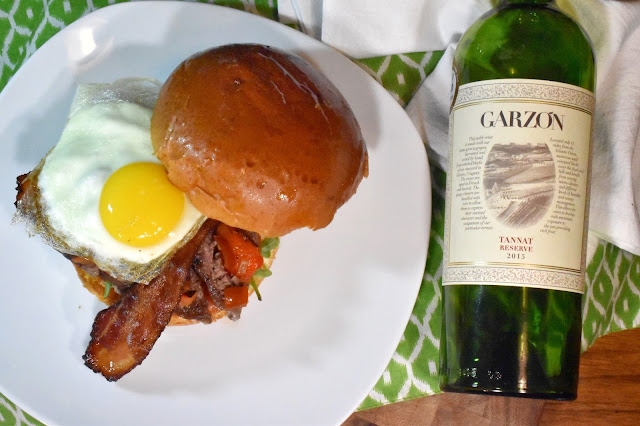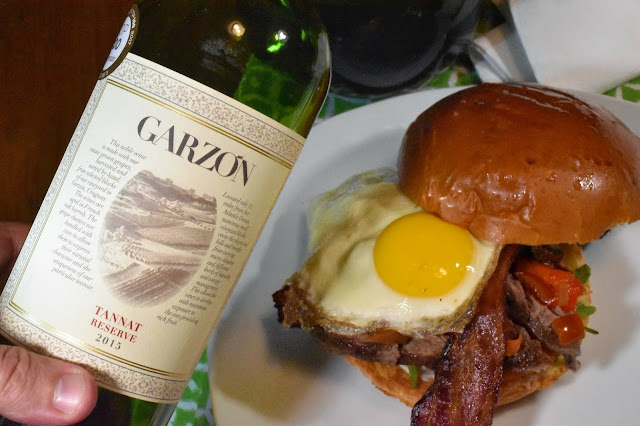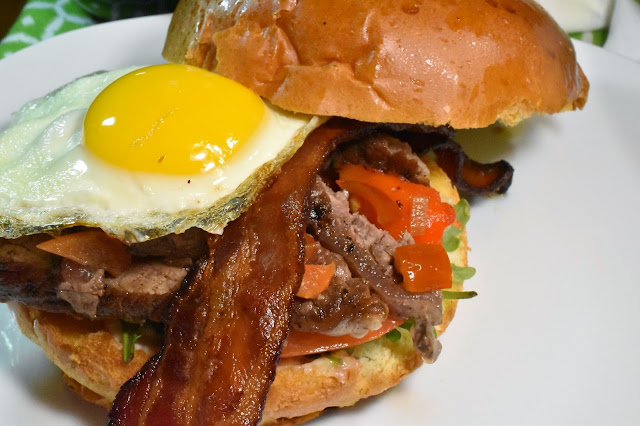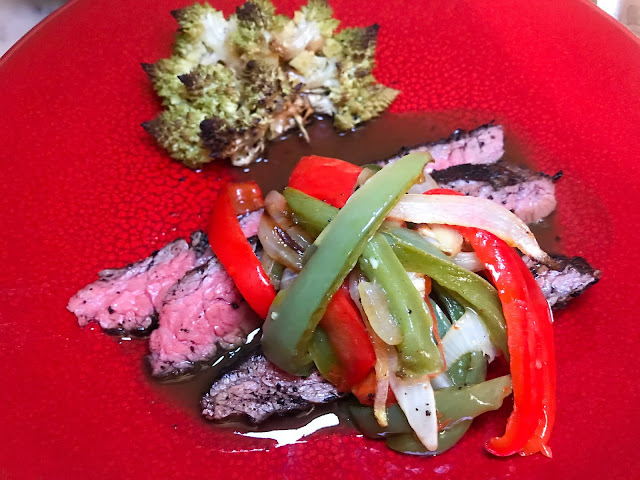Two Rounds with Bodega Garzón Tannat: Chivitos and Chipotle-Coffee Flank Steak
We are all about the antioxidants at the moment! Today’s featured grape, Tannat, is full of them. Much like Sagrantino (featured in the last two posts) this is a grape that is high in tannins, which are polyphenols, which are antioxidants. So if you’re looking for wines most likely to serve as an elixir of life, this is another good candidate.
Ok, maybe that’s a bit of an exaggeration. Maybe.
Tannat’s history is an interesting one, in many ways comparable to that of Malbec and Carménère, as all of these grapes emigrated from region’s in France and found new homes in the New World in South America. Malbec landed in Argentina, Carménère in Chile, and Tannat in Uruguay. Much like Malbec, Tannat started out in the South West region of France. Tannat’s French stronghold is in Madrian, but it also contributes to the blends from Irouléguy, Saint-Mont, Côtes du Brulhois, Béarn, and Tursan.
This is Basque country. The area lies on the border between France and Spain spilling out from the the Pyrenees Mountains. As was often the case, settlers longing to bring a taste of home with them as they moved to a new land would bring their vines with them. In this case, a Basque settler named Don Pascual Harriague was likely the first to bring over Tannat when he crossed the Atlantic to settle in Uruguay in the 19th-century. For a long time the grape even bore his name in Uruguay.
What’s particularly interesting about this grape’s journey is that the oldest Tannat vines currently in Uruguay are actually closer to the original Tannat from Madiran, than what it currently found in Madiran today. Phylloxera, nasty bug that it is, wiped out most of the vines in France, so their grapes had to replanted. The oldest vines in Uruguay, however, are directly descended from vines that existed before the bug wreaked all its havoc in their home country.
The two strains differ in that Tannat from Uruguay tends to be a little lower in tannin and the tannins tend to be smoother than those from Madiran. Of course the climate has its role to play as well, and Tannat seems to be quite happy in Uruguay. Things are only getting better as winemaking techniques improve.
Either way though, the tannins is Tannat are undeniable and they need taming. These wines take well to techniques that help to soften ‘em up and smooth ‘em out, like oak aging or micro-oxygenation–a technique where tiny amounts of oxygen are sent through the wine to help those feisty tannins chillax. Not surprisingly, this technique also originated in Madiran. The grape also tends to be pretty high in acidity. With all that structure, you might be able to guess that wines also tend to keep well in the cellar for a long time.
THE WINE & PAIRINGS
This is a grape that is very much still on upward trajectory both in terms of quality and recognition. As such, you can find solid bottles at reasonable price points. Today’s wine – the Bodega Garzón Tannat Reserva Uruguay 2015 – was the first Tannat to make it onto Wine Spectator’s Top 100 list, and that just happened in 2017. The winery was also named New World Winery of the year by Wine Enthusiast in 2018. Not that awards and accolades are everything, but I do think it’s cool when an underdog grape or region breaks through to gain recognition. The also retails for under $20.
The winery puts a lot of focus on sustainability. It’s apparently the first winery to be LEED Certified (Leadership in Energy & Environmental Design) outside of North America.
The winery is named for the small town of Garzón, which is near Uruguay’s Atlantic coast and has recently become something of a culinary destination. Wine, food, and ocean views – I’m so ready to go!
Actually, in researching this bottle I was confronted with the fact that I knew very little about Uruguay’s cuisine. My family is Venezuelan. My parents have lived in quite a few places in Latin America. I’ve traveled a good bit throughout Latin America, and to some degree have explored the cuisines of quite a few countries on top of that. Still . . . Uruguay’s food was pretty much a blank for me. I wanted to rectify the situation, in some minor way at least.
Most sources compared the food to that of Argentina, thanks in part to the fact that both had a lot of influence from Italian immigrants that moved to the countries. One distinctive dish kept coming up though–the Chivito. Uruguay’s Chivito is a beef sandwich that can be topped with a variety of ingredients, but egg, bacon, ham, lettuce, tomato, onions, mayonnaise are common. (Argentina also has a Chivito, but in their case, the sandwich is made with goat.)
This sounded freak’n awesome! Even though I hadn’t tasted the wine yet, it seemed like it would be a good match. I used this recipe by Chef Ignacio Mattos I found on Saveur.com as my guide. (Other recipes I looked at topped it off with Chimichurri, so feel free to use some here as well.) I didn’t really change anything major other a few minor details to make use of items available on hand, and I sliced the steaks once they’d had a chance to rest to make them easier to eat. I did decide to top the sandwiches with fried eggs instead of hard-boiled, simply because we really love a runny egg.
The sandwiches were in fact, 100% freak’n awesome. The wine, however, was corked. Wah, wah. It was only lightly corked, so I could still get enough from the wine to pretty confidently think that it would have been a good match. Between the steak, the fattiness of the bacon, and the richness of the egg, I’m pretty sure it would have tamed the tannins nicely.
It’s not a huge deal. TCA happens. However, I was bummed as I was still curious to try the wine since it had been a couple of years since I’d had a Tannat from Uruguay. I decided to go for round two and I had Greg pick up a second bottle for me.
Bottle two was a whole different ball game. We picked up notes of blackberries, smoked plums, maybe even a hint of blueberry. There were also lots of spice notes: coffee, spice cake, and a hint of star anise. It was full bodied; very dense and rich, with strong but rounded tannins, and enough acidity to hold it all together. We definitely decanted this big, burly wine to give it plenty of time to open up.
For this second dance with the wine, I decided to revisit one of the very first recipes I ever did for 8 & $20 on Wine Spectator: Flank Steak with Chipotle-Coffee Sauce. The only thing I changed this time was that I used coffee grounds as part of the rub for the flank steak, as well as using coffee in the sauce. I figured this wine would be able to handle it and it did. The extra char and flavor coming off of the steak played up smoky notes in the wine. The wine and food made a delicious match with the spice notes in the sauce and steak melding easily with those in the wine, and of course the meatiness was a great match for the tannins in the wine.
OTHER POSSIBILITIES
This is a great wine to try if you’re a California Cab lover looking to branch out. The wine has similarly smooth tannins, and an even fuller-body. When I originally wrote the flank steak article, I recommended a fuller Malbec and a Cab (both from Mendoza) and all of these wines would certainly make good options for anything charred and meaty like these two dishes. Rich, deep, stews and braises would be delicious in combination with this wine as well.
The winery recommends “regional dishes such as local lamb. Cured cheeses like Parmesan or a duck cassoulet showcase the wine’s spicy notes. It pairs perfectly with traditional French cuisine.”
Joseph Swan, here in Sonoma, makes a good California version of Tannat. It would make a fun side-by-side comparison to line up these two, plus one from Madiran. Noted for future experiments.
Try them with this recipe for Pistachio-Crusted Rack of Lamb With Pomegranate-Mint Bulgur Wheat I paired with a Madiran for another 8 & $20.
THE GEEKY DETAILS
From the Tech Sheet:
VARIETY: 100% Tannat
REGION: Garzón, Uruguay
ALCOHOL: 14.5%
RESIDUAL SUGAR: 3.5 g/L
ACIDITY (H2T): 5.2 g/L
PH: 3.71
FERMENTATION: 80 HL Cement Tanks
AGING: 12 to 18 months on the lees in French oak barrels and casks.
OENOLOGIAL CONSULTANT: Alberto Antonini
WINEMAKER: Germán Bruzzone
VITICULTURIST: Eduardo Félix
REGION: Garzón, Uruguay
ALCOHOL: 14.5%
RESIDUAL SUGAR: 3.5 g/L
ACIDITY (H2T): 5.2 g/L
PH: 3.71
FERMENTATION: 80 HL Cement Tanks
AGING: 12 to 18 months on the lees in French oak barrels and casks.
OENOLOGIAL CONSULTANT: Alberto Antonini
WINEMAKER: Germán Bruzzone
VITICULTURIST: Eduardo Félix
MONEY TALK
I picked up my bottle at Wine on Piedmont for about $18 and I’d say that’s totally reasonable. (The average price on Wine-Searcher is $19.) It’s definitely a Solid Value, and probably an Overachiever.
A couple more shots just to tempt you.
Photo credit on the Chivito pictures to Greg Hudson. Flank Steak pics were me.
*****
The rest of the Wine Pairing Weekend group is also exploring wines from Uruguay this week. Check out their posts here:
- Pinny at Chinese Food and Wine Pairings presents Uruguay’s Bodega Garzon Tannat Paired with Lamb Skewers and Beef Short Ribs.
- Camilla from Culinary Adventures with Camilla gives us Brined Quail with a NumberedBottle of Tannat.
- Cindy from Grape Experiences provides Taste Uruguay: 1752Gran Tradicion Montevideo 2017 and Pasta with Caruso Sauce.
- David from Cooking Chat stirs up BBQ Baked Steak Tips with Wine from Uruguay.
- Wendy from A Day In The Life On The Farm presents Food and Wine of Uruguay: Chivito Sandwiches Paired with Garzon Cab Franc.
- Jeff from FoodWineClick! offers up Picturing Uruguay with Lentil Stew & Aguara Tannat.
- Kat from Bacchus Travel & Tours hints at a Hidden Gem: On the Hunt for Wine from Uruguay.
- Jane from Always Ravenous stirs up Discovering Uruguayan Wine Paired with a Winter Plate.
- Steven from Steven’s Wine And Food Blog shares Tannat and Brazilian Feijoada.
- Linda from My Full Wine Glass asks Meatless in Uruguay –Is that Possible?
- Deanna from Asian Test Kitchen says Relax Your Mussels with Uruguayan Albarino.
- Sarah from Curious Cuisiniere pairs Tannat from Uruguay and French Cassoulet.
- Nancy from Pull That Cork offers Uruguay: a Wine and Food Sampler.
- Gwendolyn from Wine Predator shares Uruguay: Influenced by Immigrants Plus 7 Fun Facts.
- Jennifer from Vino Travels presents Bodega Garzón Tannat with Sausage Stew.
- Martin of ENOFYLZ Wine Blog writes A Taste of the Food and Wine of Uruguay
- Rupal from Syrah Queen is ready with Tannat – The National Grape of Uruguay.
- Jill at L'Occasion, this month's host, rolls out To All The Foods I’ve Loved Before: Pairing Uruguayan Tannat.
Additional sources and reading:
The Oxford Companion via JancisRobinson.com
Tags:
#WinePW
Back of the House
Chivitos
Front of the House
Overachievers
sandwiches
Solid Value
Steak
tannat
Uruguay
wine pairing
Wine Pairing Weekend










8 comments
I made the Chivito as well....what an amazing sandwich, yours is a little different than mine but that is the beauty of traditional recipes. The flank steak sounds wonderful as well. Glad you got to sleep in a bit this morning.
ReplyDeleteYou and I were very much on the same wavelength. Loved this sandwich too! And yes . . . getting over a cold and I guess I needed the sleep. Ha!
DeleteThis is a lovely post. I like all the details and substitution you offere and the tidbit about getting corked wine because I've gotten more than a few of those bottles. I was exactly afraid of those big tannins in Tannat, but maybe I'll give it a try one day...
ReplyDeleteThanks Deanna! There was a lot of tannin, but they tend to be pretty round and smooth in the ones from Uruguay. Definitely worth a shot!
DeleteI definitely want to try making some Chivitos sandwiches. They look so decadent, perfect to go with that heart-healthy Tannat!
ReplyDeleteThey were really worth it!
DeleteClassics Uruguayan street food! Looks fantastic.
ReplyDeleteThanks Jill -- It was!
DeleteThanks so much for leaving your comments and questions. I always love to hear from you!